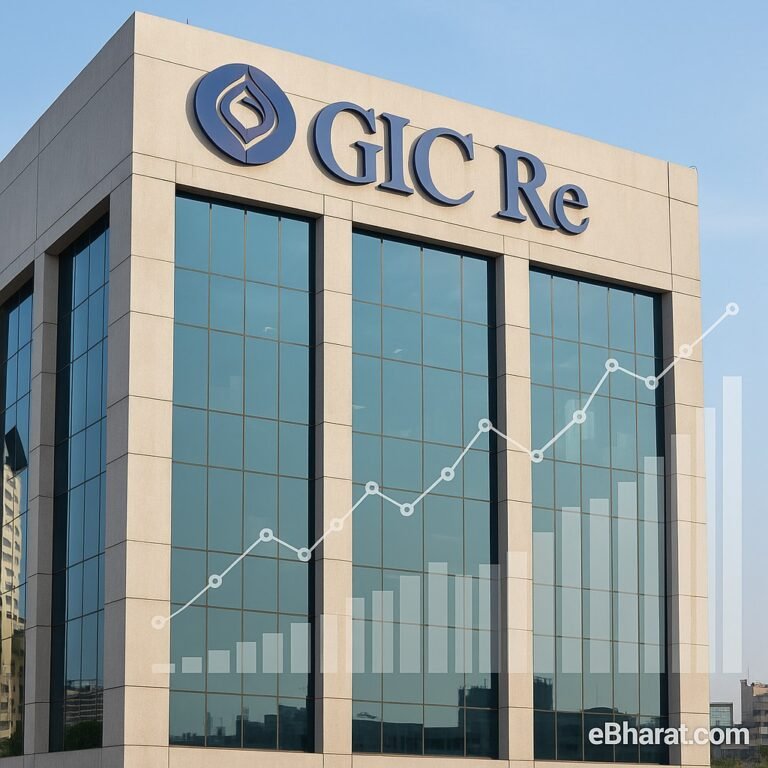
Introduction
When an insurance company itself wants protection, who covers them? That’s where reinsurance comes in.
Reinsurance is like “insurance for insurers.” Without it, even a big company like LIC or HDFC Life could struggle if lakhs of claims hit together — for example, after a cyclone in Odisha or a flood in Chennai.
In India, reinsurance is a growing market. Premiums touched ₹75,000 crore in FY2024, and IRDAI has opened the sector further for global players. Let’s understand this world that mostly works behind the scenes but impacts your policy premiums directly.
What is Reinsurance?
Reinsurance is when an insurance company transfers part of its risk to another company (the reinsurer).
- Insurer = sells policies to customers (like ICICI Lombard).
- Reinsurer = covers part of insurer’s liability.
Example: Suppose an insurer issues ₹1,000 crore worth of crop insurance. If a drought hits, they can’t pay all claims alone. Reinsurer steps in to share the burden.
Types of Reinsurance
- Facultative Reinsurance
- Covers a single large risk, like a power plant or refinery.
- Negotiated case by case.
- Treaty Reinsurance
- Covers a whole portfolio of policies (motor, health, etc.).
- Ongoing arrangement between insurer and reinsurer.
- Proportional (Quota Share)
- Insurer and reinsurer share premiums and claims in fixed ratio.
- Example: 50-50 split.
- Non-Proportional (Excess of Loss)
- Reinsurer pays only if claims exceed a threshold.
- Example: Insurer pays up to ₹50 crore; beyond that, reinsurer kicks in.
Reinsurance Market in India (2025)
- GIC Re (General Insurance Corporation of India) – state-owned, dominant player, holds compulsory cession from Indian insurers.
- Foreign Reinsurers – Swiss Re, Munich Re, Hannover Re, Lloyd’s, SCOR.
- Branches in India – Many global reinsurers now have offices in Mumbai under IRDAI approval.
- Brokerage Firms – Reinsurance brokers like Marsh, Aon, Guy Carpenter operate in arranging deals.
| Reinsurer | Presence in India | Specialisation |
|---|---|---|
| GIC Re | State-owned, Mumbai HQ | All lines, compulsory cession |
| Swiss Re | Branch office, Mumbai | Health, catastrophe cover |
| Munich Re | Branch office, Mumbai | Life, crop, motor |
| Lloyd’s of London | Service company in India | Specialty & global risks |
| SCOR | Branch office, Mumbai | Life reinsurance |
*Data: IRDAI Reinsurance Market Report, 2024.
Why Reinsurance Matters to You
A common question: Why should a policyholder care about reinsurance?
Because it directly affects:
- Premiums you pay – If insurers can spread risk, premiums stay stable.
- Claims getting paid – During disasters, reinsurance ensures insurers don’t collapse.
- Market stability – It prevents a domino effect where one insurer’s failure hits customers.
Real example: In Kerala floods (2018), reinsurance helped insurers settle over ₹2,700 crore in claims. Without it, many claims would have remained stuck.
IRDAI Rules & 2025 Updates
- Order of Preference: Indian reinsurers (like GIC Re) get first preference, then branches of foreign reinsurers.
- Cession Limits: Insurers must cede a minimum percentage of risks to GIC Re (currently 5%).
- Sandbox Rules: IRDAI is testing parametric reinsurance (automatic payouts on weather triggers).
- Solvency Boost: Reinsurance contracts help insurers maintain solvency ratios as per IRDAI norms.
Why it matters: Indian insurers can underwrite bigger risks — like airports, highways, mega hospitals — without fearing bankruptcy.
Reinsurance vs Insurance
| Feature | Insurance | Reinsurance |
|---|---|---|
| Who Buys | Individuals, businesses | Insurance companies |
| Purpose | Protect family/assets | Spread insurer’s risk |
| Contract Period | Usually 1 year | 1 year or multi-year treaties |
| Example | Health, motor, home policy | Crop portfolio, catastrophe risk |
🌟 Want to build your career in insurance?
Join eBharat’s Agent Network → Apply Now
Challenges in India
- Heavy reliance on GIC Re, despite foreign entries.
- Lack of depth in catastrophe modelling.
- Crop insurance losses create strain.
- Reinsurance premiums are rising globally due to climate change.
FAQs
Q. Who regulates reinsurance in India?
IRDAI (Insurance Regulatory and Development Authority of India).
Q. Do reinsurers deal with customers directly?
No, only with insurers. Customers never interact with reinsurers.
Q. Can reinsurance reduce my premium?
Indirectly yes — it stabilises premiums by spreading risk.
Q. Is GIC Re the only Indian reinsurer?
Yes, GIC Re is the only domestic reinsurer, but foreign reinsurers also operate through branches.
Future of Reinsurance in India
- More catastrophe bonds and alternative risk transfer.
- Climate-focused reinsurance products for floods, heatwaves.
- Growth in life reinsurance with rising term insurance adoption.
- Digital risk modelling with AI and satellite data.
Reinsurance is invisible to most policyholders but without it, the insurance sector cannot survive. It ensures your claim gets paid even when disasters hit.
In 2025, with IRDAI reforms and global reinsurers in India, the sector is set for growth. For policyholders, it means more stability, better claim settlement, and controlled premiums.
This guide is prepared by eBharat.com — verified with IRDAI updates (2025).
🤝 Ready to Grow With Insurance?
Reinsurance may run the backbone of the industry, but agents are the real face of insurance. Join eBharat’s HDFC Life Agent Network and access tools, training, and mentorship to start your journey in 2025.
- 📊 Digital PlanMatch comparison tools
- 🎯 Ready-to-use sales scripts & templates
- 💬 WhatsApp Starter Kit for instant leads
- 🤝 One-on-one onboarding & support













